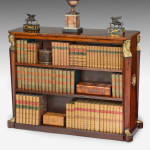Regency Ormolu-mounted Double-sided Bookcase
ENGLAND, CIRCA 1810
Mahogany, amboyna, kingwood, boxwood and ebony inlay, pine shelves
84 x 107 x 38 cm
33 x 42 ¼ x 15 in
33 x 42 ¼ x 15 in
7129
Further images
Provenance
Jeremy Ltd., 1996Private UK Collection
The top of burr yew crossbanded in rosewood, with a mahogany base raised on casters, decorated to each corner with ormolu, mahogany and ebony-inlaid caryatids in the Egyptian taste, the...
The top of burr yew crossbanded in rosewood, with a mahogany base raised on casters, decorated to each corner with ormolu, mahogany and ebony-inlaid caryatids in the Egyptian taste, the sides with the original round ormolu carrying handles in the form of lion's heads. Bears a paper label to the underside "117 White & Co., Ltd., Furniture Depositories, Name: Mrs. V. Barker, No. 96, Winchester, Southampton, London, Portsmouth and Bournemouth."
The Egyptian Revival arose in the 19th century in Europe and was characterized by designs incorporating Egyptian motifs, symbolism and architectural forms. Such forms were popularised by Napoleon's expeditions to Syria and Egypt from 1798-1801 which were recorded in Vivant Denon’s ‘Voyage dans la Basse et la Haute Egypte, pendant les campagnes du général Bonaparte’, published in 1802. Denon was the leading archaeologist on the expedition.
By promoting the study of Egypt's monuments and the legacy of the ancients, Napoleon aimed to magnify his own glory. When he was defeated in Egypt in 1798 and at Trafalgar in 1805, the reflection of this legacy through Egyptian style was adopted in England to symbolise Nelson's victories in a similar way, particularly amongst royalty and other wealthy patrons.
In addition to Denon’s work, other publications contributed to the cultural popularisation of Egypt, including ‘Travels in Upper and Lower Egypt’ by C.S. Sonnini, translated from the French by Henry Hunter and printed in three illustrated volumes in 1799; ‘Nouveau voyage dans la Haute et Basse Égypte, la Syrie, le Dar-Four, oú aucune Européen n'avoit pénétré : fait depuis les années 1792 jusqu'en 1798 ; avec des notes critiques sur les ouvrages de Savary et de Volney’ by William George Browne and Jean-Henri Castéra, published in 1800. This was reflected in art and design in works by such influential figures as Charles Percier and Pierre-Franois-Lionard Fontaine in France with their Receuil (1812). Thomas Hope and George Smith were amongst the English designers who incorporated Egyptian elements into their work. The Egyptian taste became highly fashionable in the early part of the 19th century, reflected in grand houses such as Crawley House, Bedfordshire, Harewood House, Yorkshire, Deepdene, Surrey (home of Thomas Hope) and Stourhead, Wiltshire.
The Egyptian Revival arose in the 19th century in Europe and was characterized by designs incorporating Egyptian motifs, symbolism and architectural forms. Such forms were popularised by Napoleon's expeditions to Syria and Egypt from 1798-1801 which were recorded in Vivant Denon’s ‘Voyage dans la Basse et la Haute Egypte, pendant les campagnes du général Bonaparte’, published in 1802. Denon was the leading archaeologist on the expedition.
By promoting the study of Egypt's monuments and the legacy of the ancients, Napoleon aimed to magnify his own glory. When he was defeated in Egypt in 1798 and at Trafalgar in 1805, the reflection of this legacy through Egyptian style was adopted in England to symbolise Nelson's victories in a similar way, particularly amongst royalty and other wealthy patrons.
In addition to Denon’s work, other publications contributed to the cultural popularisation of Egypt, including ‘Travels in Upper and Lower Egypt’ by C.S. Sonnini, translated from the French by Henry Hunter and printed in three illustrated volumes in 1799; ‘Nouveau voyage dans la Haute et Basse Égypte, la Syrie, le Dar-Four, oú aucune Européen n'avoit pénétré : fait depuis les années 1792 jusqu'en 1798 ; avec des notes critiques sur les ouvrages de Savary et de Volney’ by William George Browne and Jean-Henri Castéra, published in 1800. This was reflected in art and design in works by such influential figures as Charles Percier and Pierre-Franois-Lionard Fontaine in France with their Receuil (1812). Thomas Hope and George Smith were amongst the English designers who incorporated Egyptian elements into their work. The Egyptian taste became highly fashionable in the early part of the 19th century, reflected in grand houses such as Crawley House, Bedfordshire, Harewood House, Yorkshire, Deepdene, Surrey (home of Thomas Hope) and Stourhead, Wiltshire.












